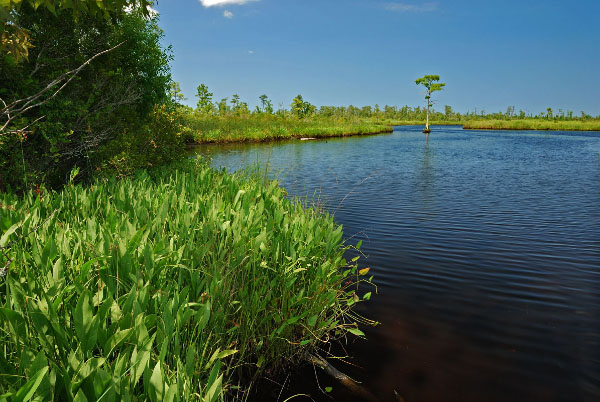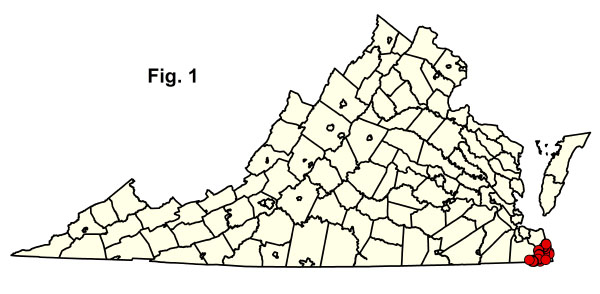

Virginia Department of Conservation and RecreationAn official website of the Commonwealth of Virginia Here's how you knowAn official websiteHere's how you know

Virginia Department of Conservation and RecreationAn official website of the Commonwealth of Virginia Here's how you knowAn official websiteHere's how you know
 Department of Conservation and Recreation
Department of Conservation and Recreation
 Table of Contents
Table of ContentsWind-Tidal Oligohaline Marshes
These herbaceous wetlands are subject to irregular wind-tidal flooding along the shores of estuaries that have been cut off from oceanic influences by the closure of inlets. They are well documented only in the mid-Atlantic Embayed Region of southeastern Virginia and northeastern North Carolina. Similar environments and vegetation are known from low-salinity backbays and lagoons in the South Atlantic and Gulf Coastal Plains. In Virginia, these communities are essentially confined to the North Landing and Northwest Rivers (tributaries of Currituck Sound) and Back Bay in the extreme southeastern part of the state. Although these systems are no longer influenced by lunar tides, wind-driven currents may produce as much as 1 m (3 ft) of variation in water levels and contribute to a salinity regime that fluctuates between completely fresh and about 5 ppt. Occasional stands of irregularly lunar-tidal oligohaline marsh further north are compositionally consistent with the Embayed Region stands, but their status is somewhat uncertain.
Vegetation consists of a mixture of freshwater species and species more typical of mesohaline marshes. Patch-dominance of the tall marsh graminoids big cordgrass (Spartina cynosuroides), black needlerush (Juncus roemerianus), and cattails (Typha angustifolia and less frequently Typha latifolia) is common, although diverse tall marshes with big cordgrass, sawgrass (Cladium jamaicense), switchgrass (Panicum virgatum var. virgatum), horned beaksedge (Rhynchospora macrostachya), swamp rose-mallow (Hibiscus moscheutos), few-flower milkweed (Asclepias lanceolata), and other species also occur on a more limited basis.
More locally distributed are patches of diverse short-statured marshes characterized by creeping spikerush (Eleocharis fallax), beaked spikerush (Eleocharis rostellata), twig-rush (Cladium mariscoides), Olney threesquare (Schoenoplectus americanus), bull-tongue arrowhead (Sagittaria lancifolia var. media), pickerelweed (Pontederia cordata var. cordata), dotted smartweed (Persicaria punctata), Canadian rush (Juncus canadensis), and a large number of minor associates. Shallow, muck-filled pools within the marshes contain patches of white water-lily (Nymphaea odorata ssp. odorata).
Community types of the mid-Atlantic wind-tidal marshes are endemic to southeastern Virginia and northeastern North Carolina, are considered globally rare, and support a substantial number of state-rare plants and animals. Threats include ditching, water pollution, boat wakes, and destruction by nutria (Myocastor coypus), a naturalized exotic mammal. Fire is reported to be an important ecological factor in maintaining the diversity of these marshes. A recent decline in fire frequency in most localities appears to be contributing to extensive expansion of black needlerush colonies at the expense of many less competitive species.
References: Coulling (2002), Fleming and Moorhead (1998), Frost (1995), Moore (1992), Priest and Dewing (1991).
Click here for more photos of this ecological community group.
 © DCR-DNH, Gary P. Fleming.
© DCR-DNH, Gary P. Fleming.

 Download a spreadsheet of compositional summary statistics (Excel) for each of the community types listed below.
Download a spreadsheet of compositional summary statistics (Excel) for each of the community types listed below. 
